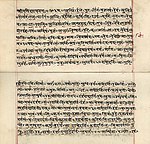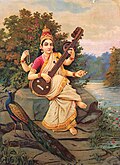Portal:Hinduism/Selected article
historical reference. . Either the page is no longer relevant or consensus on its purpose has become unclear. To revive discussion, seek broader input via a forum such as the village pump |
| Note: Selected article entries are now listed at Portal:Hinduism/Selected articles. However, this page should be retained for historical reference. |
Usage
The layout design for these subpages is at Portal:Hinduism/Selected article/Layout.
- Add a new Selected article to the next available subpage.
- Update "max=" to new total for its {{Random portal component}} on the main page.
Selected articles list
Portal:Hinduism/Selected article/1
Yoga as a means of spiritual attainment is central to
The four main paths of Yoga are
Portal:Hinduism/Selected article/2
Dharma is a key concept with multiple meanings in Hinduism and other Indian religions such as Buddhism, Sikhism and Jainism. In
Dharma is an ancient concept, that evolved over time in India. The word Dharma appears over fifty times in the Rigveda, dated to be from the 2nd millennium BCE. The concept takes a central place in later Vedic era texts and post-Vedic era Sanskrit literature. Dharma includes the pursuit and execution of one’s nature and true calling, thus playing one’s role in cosmic concert. In Hinduism, it is the dharma of the bee to make honey, of cow to give milk, of sun to radiate sunshine, of river to flow. In terms of humanity, Dharma in Hinduism is the need for, the effect of and essence of service and interconnectedness of all life.
Portal:Hinduism/Selected article/3
The Trimurti is a concept that holds that God has three aspects, which are only different forms of the same one God. The three aspects of God are Brahma (the Source/Creator), Vishnu (the Preserver/Indwelling-life) and Shiva (the Transformer -Destroyer/Creator). According to the Trimurti belief, these three personae of God are simply different aspects of the one and the same God.
Though all the three trimurti's are males, each aspect has a female consort, all of which are manifestations of the Supreme Goddess
Portal:Hinduism/Selected article/4
Karma is closely associated with the idea of rebirth in some schools of Hinduism, wherein the karma of an individual in the present affects one's future in the current life, as well as the nature and quality of future lives - or, one's saṃsāra. Other schools of Hinduism, the karma theory impacts an individual's current life by shaping his or her future circumstances in current life, while the present circumstances of the individual are explained with reference to his or her intent and actions in the past. Over time, various schools of Hinduism developed many different definitions of karma, some making karma appear quite deterministic, while others make room for free will and moral agency. The results or "fruits" of actions are called karma-phala.
Karma is an important theory of ethics, and is central to the historical free will and destiny debate within various schools of Hinduism. Karma concept can be traced back to the early Upanishads. All living creatures are responsible for their karma, according to Hinduism. The effects of all intents and deeds, engaged in or avoided consciously or unconsciously, actively create circumstances, thus making one responsible for one's own life, and the suffering and joy it brings to self and others.
Portal:Hinduism/Selected article/5
Angkor Wat combines two basic plans of Khmer temple
Portal:Hinduism/Selected article/6
The ), freedom and a content, happy life in Hinduism.
The Upanishads are the foundation of Hindu philosophical thought and its diverse traditions. Of the Vedic corpus, they alone are widely known, and the central ideas of the Upanishads are at the spiritual core of Hindus.
More than 200 Upanishads are known, of which the first dozen or so are the oldest and most important and are referred to as the principal or main (
Portal:Hinduism/Selected article/7
Portal:Hinduism/Selected article/8
The
The Vedas are considered
There are four Vedas: the
The various Indian
Portal:Hinduism/Selected article/9
as the one Supreme God.
Portal:Hinduism/Selected article/10
Portal:Hinduism/Selected article/11
Brahman (Sanskrit: ब्रह्मन्) is a key concept in Hinduism, connoting the highest Universal, the Ultimate Reality in the universe. It is, in major schools of Hindu philosophy, the material, efficient, formal and final cause of all that exists. It is the single binding unity behind the diversity in all that exists in the universe. There is no single word translation for the concept of Brahman, and it has various shades of meaning in the various schools of Hinduism. The ancient texts of Hindus variously describe Brahman as the eternal, the infinite which never changes yet is cause of all changes; the "creative principle which lies realized in the whole world"; the "essence of the universe"; the "deeper foundation of all phenomena"; the "essence of the self (Atman, soul)"; and the deeper "truth of a person beyond apparent difference".
Brahman in theistic sub-schools of Hinduism is the genderless,
Portal:Hinduism/Selected article/12
The
The total length of the river is about 2,510 km (1,557 mi). Along with another river
The picture shows Hindus putting lit candles on the Ganges thus demonstrating their immense reverence for the great river.
Portal:Hinduism/Selected article/13
Portal:Hinduism/Selected article/14
respectively.
Saraswati as a goddess is mentioned in the most ancient layer of Sanskrit texts of Hinduism, namely the Rigveda. She has remained significant as a goddess from the Vedic age through modern times of Hindu traditions. She is generally shown to have four arms, but sometimes just two. When shown with four hands, those hands hold a pustaka (book or script), a mala (rosary, garland), a water pot and a musical instrument. Each of these items have symbolic meaning in Hinduism.
Some Hindus celebrate the festival of Vasant Panchami (the fifth day of spring) celebrating goddess Saraswati, and mark the day by helping young children learn how to write alphabets on that day. Saraswati as a goddess of knowledge, music and arts is also found outside India, such as in Japan, Vietnam, Bali (Indonesia) and Myanmar.
Portal:Hinduism/Selected article/15
The term Maya of Hinduism is sometimes translated as 'illusion', but Maya does not concern normal illusion. In Hinduism, Maya or 'illusion' does not mean that the world is not real and simply a figment of the human imagination. Maya means that the world is not as it seems; the world that one experiences is misleading as far as its true nature is concerned. The true is that which never changes asserts Hinduism, it is the hidden essence and the pristine principles that drive change yet remain unchanged. Maya concept in Hinduism is often discussed with the concept of Atman (soul, self) and Brahman (cosmic soul, eternal universal). Maya is born, changes, evolves, dies with time, from circumstances, due to invisible principles of nature. Atman-Brahman is eternal, unchanging, invisible principle, unaffected absolute and resplendent consciousness. The universe, time and all life is viewed as a holistic expression of Māyā and Ātman in Hinduism.
Portal:Hinduism/Selected article/16
Bhagavān, in most contexts, is an epithet for God, particularly for Krishna and other avatars of Vishnu in Vaishnavism, as well as for Shiva in Shaivism tradition of Hinduism. Bhagavān also represents the concept of abstract God to Hindus who are religious but do not worship a specific deity. Bhagavan is male in Bhakti traditions, and female equivalent of Bhagavān is Bhagavatī.
The term Bhagavān does not appear in
Portal:Hinduism/Selected article/17
Ahimsa is a term that means 'not to injure'. Ahimsa concept includes nonviolence against all human beings and all living beings - including animals - in Hinduism and other Indian religions. It is one of the cardinal virtues in Hinduism and a central premise of its ethical theories.
Ahimsa is a multidimensional concept in Hinduism inspired by the premise that all living beings have the spark of the divine spiritual energy; to hurt another being is to hurt oneself. Ahimsa's precept of 'cause no injury' includes injury to any living being through one's deeds, words, and thoughts.
The
Portal:Hinduism/Selected article/18
Portal:Hinduism/Selected article/19
Portal:Hinduism/Selected article/20
Nominations
Feel free to add Featured, top or high importance Hindu mythology, Hindu philosophy, or Hinduism articles to the above list. Other Hinduism-related articles may be nominated here.
Current nominations
Choose the next "Selected article":
Varanasi
- Reason: Holiest city, sounds adequate.
- Date to be selected: Anytime
- Sign with date: Húsönd 21:25, 12 January 2007 (UTC)
Ganesha
- Reason: One of the most identifiable and popular Hindu gods (& is a GA)
- Date to be selected: Anytime
- GizzaChat © 03:37, 13 January 2007 (UTC)
 Approved. Arjun 04:11, 13 January 2007 (UTC)
Approved. Arjun 04:11, 13 January 2007 (UTC) Approved. seems ok.--Dwaipayan (talk) 04:56, 4 February 2007 (UTC)
Approved. seems ok.--Dwaipayan (talk) 04:56, 4 February 2007 (UTC)- Isn't Ganesha already a selected article - 7???? --Redtigerxyz 13:53, 10 June 2007 (UTC)
Adi Shankara
- Reason:Already a featured article, a very prominent figure in Hinduism.
- Date to be selected:no specific date
- Dwaipayan (talk) 05:03, 4 February 2007 (UTC)

















